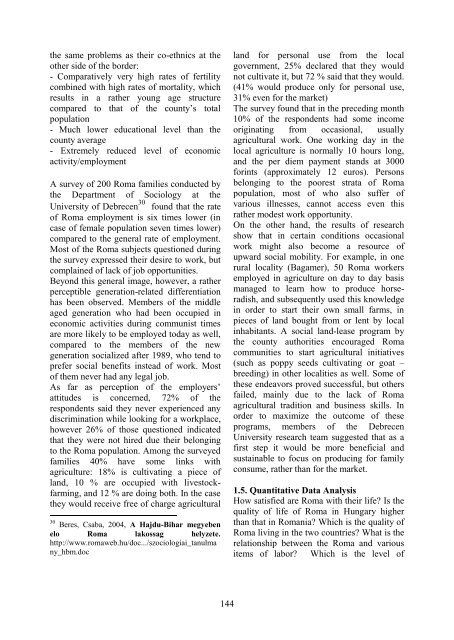Selected papers~ SPECIAL EDITION - Index of
Selected papers~ SPECIAL EDITION - Index of
Selected papers~ SPECIAL EDITION - Index of
Create successful ePaper yourself
Turn your PDF publications into a flip-book with our unique Google optimized e-Paper software.
the same problems as their co-ethnics at the<br />
other side <strong>of</strong> the border:<br />
- Comparatively very high rates <strong>of</strong> fertility<br />
combined with high rates <strong>of</strong> mortality, which<br />
results in a rather young age structure<br />
compared to that <strong>of</strong> the county’s total<br />
population<br />
- Much lower educational level than the<br />
county average<br />
- Extremely reduced level <strong>of</strong> economic<br />
activity/employment<br />
A survey <strong>of</strong> 200 Roma families conducted by<br />
the Department <strong>of</strong> Sociology at the<br />
University <strong>of</strong> Debrecen 30 found that the rate<br />
<strong>of</strong> Roma employment is six times lower (in<br />
case <strong>of</strong> female population seven times lower)<br />
compared to the general rate <strong>of</strong> employment.<br />
Most <strong>of</strong> the Roma subjects questioned during<br />
the survey expressed their desire to work, but<br />
complained <strong>of</strong> lack <strong>of</strong> job opportunities.<br />
Beyond this general image, however, a rather<br />
perceptible generation-related differentiation<br />
has been observed. Members <strong>of</strong> the middle<br />
aged generation who had been occupied in<br />
economic activities during communist times<br />
are more likely to be employed today as well,<br />
compared to the members <strong>of</strong> the new<br />
generation socialized after 1989, who tend to<br />
prefer social benefits instead <strong>of</strong> work. Most<br />
<strong>of</strong> them never had any legal job.<br />
As far as perception <strong>of</strong> the employers’<br />
attitudes is concerned, 72% <strong>of</strong> the<br />
respondents said they never experienced any<br />
discrimination while looking for a workplace,<br />
however 26% <strong>of</strong> those questioned indicated<br />
that they were not hired due their belonging<br />
to the Roma population. Among the surveyed<br />
families 40% have some links with<br />
agriculture: 18% is cultivating a piece <strong>of</strong><br />
land, 10 % are occupied with livestockfarming,<br />
and 12 % are doing both. In the case<br />
they would receive free <strong>of</strong> charge agricultural<br />
30 Beres, Csaba, 2004, A Hajdu-Bihar megyeben<br />
elo Roma lakossag helyzete.<br />
http://www.romaweb.hu/doc.../szociologiai_tanulma<br />
ny_hbm.doc<br />
144<br />
land for personal use from the local<br />
government, 25% declared that they would<br />
not cultivate it, but 72 % said that they would.<br />
(41% would produce only for personal use,<br />
31% even for the market)<br />
The survey found that in the preceding month<br />
10% <strong>of</strong> the respondents had some income<br />
originating from occasional, usually<br />
agricultural work. One working day in the<br />
local agriculture is normally 10 hours long,<br />
and the per diem payment stands at 3000<br />
forints (approximately 12 euros). Persons<br />
belonging to the poorest strata <strong>of</strong> Roma<br />
population, most <strong>of</strong> who also suffer <strong>of</strong><br />
various illnesses, cannot access even this<br />
rather modest work opportunity.<br />
On the other hand, the results <strong>of</strong> research<br />
show that in certain conditions occasional<br />
work might also become a resource <strong>of</strong><br />
upward social mobility. For example, in one<br />
rural locality (Bagamer), 50 Roma workers<br />
employed in agriculture on day to day basis<br />
managed to learn how to produce horseradish,<br />
and subsequently used this knowledge<br />
in order to start their own small farms, in<br />
pieces <strong>of</strong> land bought from or lent by local<br />
inhabitants. A social land-lease program by<br />
the county authorities encouraged Roma<br />
communities to start agricultural initiatives<br />
(such as poppy seeds cultivating or goat –<br />
breeding) in other localities as well. Some <strong>of</strong><br />
these endeavors proved successful, but others<br />
failed, mainly due to the lack <strong>of</strong> Roma<br />
agricultural tradition and business skills. In<br />
order to maximize the outcome <strong>of</strong> these<br />
programs, members <strong>of</strong> the Debrecen<br />
University research team suggested that as a<br />
first step it would be more beneficial and<br />
sustainable to focus on producing for family<br />
consume, rather than for the market.<br />
1.5. Quantitative Data Analysis<br />
How satisfied are Roma with their life? Is the<br />
quality <strong>of</strong> life <strong>of</strong> Roma in Hungary higher<br />
than that in Romania? Which is the quality <strong>of</strong><br />
Roma living in the two countries? What is the<br />
relationship between the Roma and various<br />
items <strong>of</strong> labor? Which is the level <strong>of</strong>


